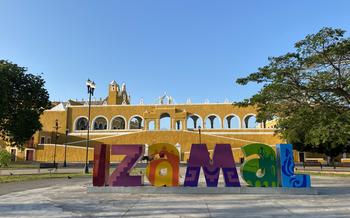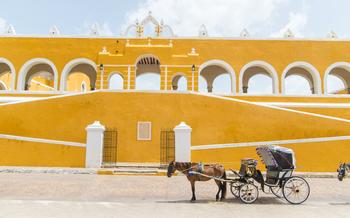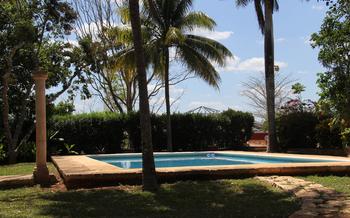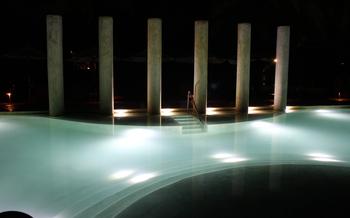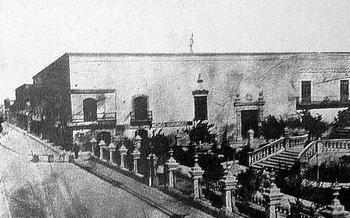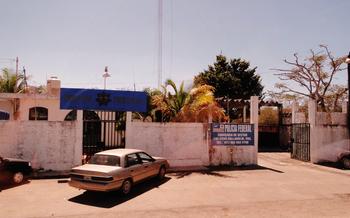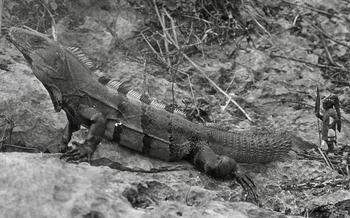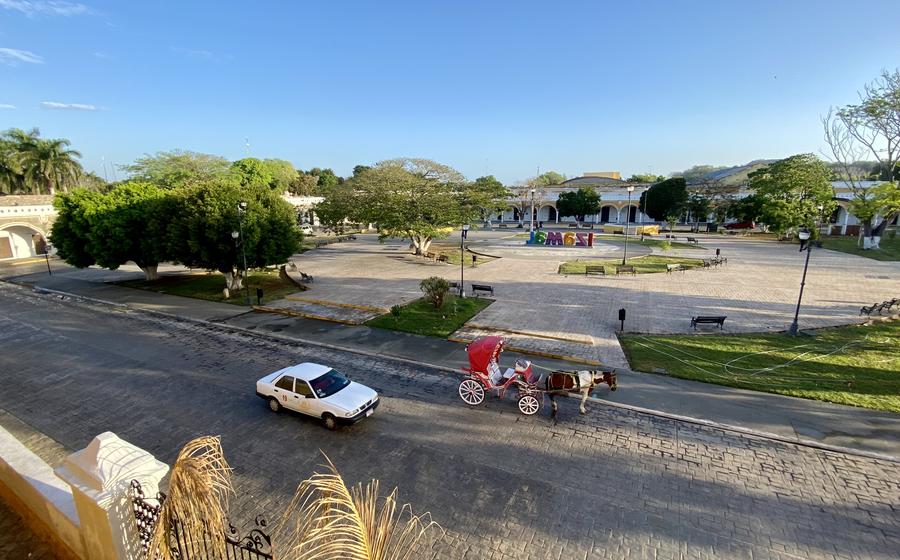
Cenote Hacienda Sotuta de Peon
- Getting to Cenote Hacienda Sotuta de Peon
- What to Expect at Cenote Hacienda Sotuta de Peon
- Swimming in the Cenote
- Staying at the Hacienda
- Things to Do Near Cenote Hacienda Sotuta de Peon
- Tips for Visiting Cenote Hacienda Sotuta de Peon
- Facts About Cenote Hacienda Sotuta de Peon
- My Personal Experience at Cenote Hacienda Sotuta de Peon
- Controversies Surrounding Cenote Hacienda Sotuta de Peon
- Insider Tip:
Getting to Cenote Hacienda Sotuta de Peon
Cenote about 45 kilometers southeast of Izamal, in the state of Yucatan, Mexico. There are a few different ways to get there from Izamal.
-
By car: The easiest way to get to the cenote is by car. The drive takes about an hour. To get there, take Highway 180 east out of Izamal. After about 30 kilometers, turn right onto Highway 29Follow Highway 295 for about 15 kilometers, and then turn left onto Calle 20. The cenote is located at the end of Calle 20.
-
By bus: There is also a bus that runs from Izamal to Sotuta. The bus leaves from the bus station in Izamal at 7:00 AM, 11:00 AM, and 3:00 PM. The trip takes about an hour and a half. To get to the bus station, walk to the corner of Calle 30 and Calle 3The bus station is located on the corner.
-
By taxi: You can also take a taxi from Izamal to the cenote. The trip takes about an hour and costs around $50. To get to the cenote, tell the taxi driver to take you to Cenote Hacienda Sotuta de Peon.
What to Expect at Cenote Hacienda Sotuta de Peon
The cenote is a large, open pool of water that is surrounded by lush vegetation. The water is crystal clear and refreshing, and it is perfect for swimming, snorkeling, and diving. The cenote is also home to a variety of fish and other aquatic creatures.
The hacienda is a beautiful, historic building that is surrounded by well-manicured gardens. The hacienda has a number of rooms that are available for rent, and it also has a restaurant and a bar. The hacienda is a popular spot for weddings and other events.
There are a number of activities that you can do at Cenote Hacienda Sotuta de Peon. You can swim, snorkel, and dive in the cenote, or you can explore the hacienda and its grounds. You can also visit the nearby town of Izamal, which is home to a number of Mayan ruins.
Swimming in the Cenote
The cenote is a popular swimming spot, and it's easy to see why. The water is crystal clear and refreshing, and the cenote is surrounded by lush vegetation that provides plenty of shade. However, there are a few things you should keep in mind before swimming in the cenote.
First, the cenote is quite deep, so it's important to be a strong swimmer. Second, the cenote is home to a variety of aquatic life, including catfish, turtles, and even crocodiles. While these animals are generally harmless, it's important to be aware of their presence. Third, the cenote is a sacred site to the Maya people, so it's important to be respectful of their culture.
Here are some rules for swimming in the cenote:
- Do not swim alone.
- Do not dive headfirst into the cenote.
- Do not touch or harass the wildlife.
- Do not litter.
- Be respectful of the Maya culture.
What to wear when swimming in the cenote:
- A swimsuit.
- Water shoes or sandals.
- A life jacket (if you are not a strong swimmer).
- Sunscreen.
- A hat.
- Sunglasses.
Staying at the Hacienda
The Cenote Hacienda Sotuta de Peon offers a variety of accommodations for visitors, from rustic cabins to luxurious suites. The cabins are located in the jungle surrounding the cenote and offer basic amenities such as a bed, a bathroom, and a fan. The suites are located in the main hacienda building and offer more luxurious amenities such as air conditioning, a private balcony, and a Jacuzzi.
Rates for the cabins start at $50 per night, while rates for the suites start at $100 per night. All rates include breakfast and access to the cenote and the hacienda's other amenities.
In addition to the standard rooms, the hacienda also offers a unique experience for guests who want to stay in a treehouse. The treehouses are located in the jungle canopy and offer stunning views of the surrounding area. Rates for the treehouses start at $150 per night.
No matter what your budget or preferences, the Cenote Hacienda Sotuta de Peon has something to offer everyone.
Things to Do Near Cenote Hacienda Sotuta de Peon
In addition to the cenote and hacienda, there are several other attractions in the area that you may want to visit.
-
Cenote Xkeken: This cenote is located just a few kilometers from Hacienda Sotuta de Peon. It is a large, open cenote with crystal-clear water. You can swim, snorkel, or dive in the cenote.
-
Ek Balam: This ancient Maya city is located about 30 kilometers from Hacienda Sotuta de Peon. It is a relatively small city, but it is home to some impressive ruins, including a large pyramid.
-
Valladolid: This colonial city is located about 45 kilometers from Hacienda Sotuta de Peon. It is a charming city with a lot of history and culture. You can visit the city's main square, the cathedral, and the Convent of San Bernardino de Siena.
For more information about these and other attractions in the area, you can visit the Izamal tourism office or the Yucatán tourism website.
Tips for Visiting Cenote Hacienda Sotuta de Peon
Visiting Cenote Hacienda Sotuta de Peon can be a great way to experience the natural beauty and rich history of the Yucatan Peninsula. Here are some tips to help you make the most of your visit:
-
Plan your visit for the early morning or late afternoon. This will help you avoid the crowds and enjoy the cenote at its most peaceful.
-
Bring plenty of water, sunscreen, and insect repellent. You'll be spending a lot of time outdoors, so it's important to stay hydrated and protected from the sun and bugs.
-
Wear comfortable shoes. You'll be doing a lot of walking and exploring, so make sure your shoes are comfortable and supportive.
-
Bring a camera to capture the stunning scenery. The cenote and hacienda are both incredibly photogenic, so you'll want to be sure to have your camera ready to capture all the beautiful moments.
-
Allow plenty of time for your visit. There's a lot to see and do at Cenote Hacienda Sotuta de Peon, so give yourself plenty of time to explore the cenote, the hacienda, and the surrounding area.
Facts About Cenote Hacienda Sotuta de Peon
The Cenote
- Depth: Approximately 20 meters (65 feet)
- Diameter: Approximately 30 meters (98 feet)
- Water Temperature: Cool and refreshing, averaging around 24°C (75°F)
- Clarity: Crystal clear, allowing for excellent visibility
The Hacienda
- Built: Late 18th century
- Architectural Style: Colonial Mexican
- Size: Over 100 hectares (247 acres) of land, including the cenote and surrounding gardens
- Main Building: A grand, two-story structure that houses the reception area, restaurant, and some guest rooms
The Sotuta Family
- Owners: The cenote and hacienda have been owned by the Sotuta family for generations
- Tradition: The family has a long tradition of hospitality, welcoming guests to their property for over a century
These facts paint a picture of Cenote Hacienda Sotuta de Peon as a remarkable place steeped in history, natural beauty, and warm hospitality.
My Personal Experience at Cenote Hacienda Sotuta de Peon
My visit to Cenote Hacienda Sotuta de Peon was an unforgettable experience. I was immediately taken by the beauty of the cenote, with its crystal-clear water and lush vegetation. The hacienda was equally impressive, with its colonial architecture and charming courtyard.
I spent the afternoon swimming in the cenote, exploring the hacienda, and enjoying a delicious meal at the restaurant. The staff was incredibly friendly and helpful, and I felt like I was truly part of the family.
One of the things I loved most about the cenote was the feeling of being completely surrounded by nature. The water was so clear that I could see all the way to the bottom, and the fish swimming around were fascinating to watch. The hacienda was also a great place to relax and unwind. I spent hours wandering around the grounds, taking photos, and soaking up the peaceful atmosphere.
If I had to do it all again, the only thing I would do differently is stay longer. There is so much to see and do at Cenote Hacienda Sotuta de Peon, and I could have easily spent a few more days exploring.
Controversies Surrounding Cenote Hacienda Sotuta de Peon
The Cenote Hacienda Sotuta de Peon has been the subject of a few minor controversies over the years. One controversy involved the cenote's water quality. In 2010, the cenote was closed for a few weeks after high levels of bacteria were found in the water. However, the cenote was quickly reopened after the water quality was improved.
Another controversy involved the hacienda's development plans. In 2015, the owners of the hacienda proposed a plan to build a new hotel and conference center on the property. However, this plan was met with opposition from local residents who were concerned about the environmental impact of the development. The owners of the hacienda eventually withdrew their plans after they were unable to reach an agreement with the local community.
Insider Tip:
- For a truly unique experience, visit the cenote at night when the stars are out. The reflection of the stars on the water creates a magical and unforgettable sight.
- If you're looking for a place to stay near the cenote, I highly recommend the Hacienda Sotuta de Peón. This beautiful hacienda offers a variety of rooms and suites, as well as a restaurant, bar, and swimming pool. -For a delicious and authentic Mexican meal, be sure to try the cochinita pibil, a traditional dish made with slow-roasted pork.

